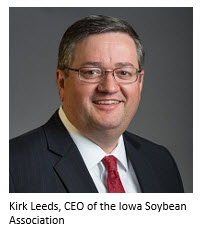WASHINGTON, Dec. 9, 2015 - Later today, the American Soybean Association (ASA) board is poised to approve a dramatic overhaul in its strategic plan for 2016-2021, bringing changes in organizational structure, member recruitment and funding.
“It’s a bold strategic plan that includes substantial changes,” noted ASA Chief Executive Officer Steve Censky in an interview with Agri-Pulse. “But I think it will serve the organization and soybean farmers for years to come.” Founded in 1920 and first organized as the National Soybean Growers’ Association in 1925, the organization now represents growers in 30 states.
 Censky
says the proposed changes, under development with state association leaders for
over a year, aim to improve the number of resources devoted to policy work
while also keeping a strong focus on trade development and expansion, and
leadership training. Changes include:
Censky
says the proposed changes, under development with state association leaders for
over a year, aim to improve the number of resources devoted to policy work
while also keeping a strong focus on trade development and expansion, and
leadership training. Changes include:
· Restructure the 45-member ASA Board of Directors and its committees so that the board can focus more time on policy and trade issues. Streamline and shorten board meetings and create advocacy teams to take the place of standing committees. Establish a goal of having 25 percent of the board composed of members who are under the age of 45 and 10 percent women and minorities by 2021.
· Increase resources and add three policy staff in ASA’s Washington, D.C., office (currently contracted through Gordley and Associates) by shifting ASA resources that have been devoted to membership recruitment.
· Provide states with flexibility to structure programs and recruit members however they believe to be most effective in their respective states. Replace ASA national membership dues with state affiliate investment levels in ASA. Member states would agree to keep their minimum investment levels in ASA the same for the next five years. However, states could invest additional funds and secure more board representation at any time.
· The structure of ASA’s voting delegate body will change, but the total numbers are expected to stay around the current size of about 132-135. The delegate body will be divided in thirds: the new board of directors (estimated to be around 45 or a bit higher); another third that equals the same number as the board and same proportion by state as the board of directors and; one-third that is proportioned according to membership as of Sept. 30, 2015. This final third that is proportioned to membership will be in place for 5 years, after which the one-third will be proportioned according to the board make-up by state.
· Establish a Soy Regulatory Issues Coalition, in partnership with states, to provide greater focus on environmental and regulatory issues at the state and national levels. The format would be similar to the existing Soy Transportation Coalition and the Aquaculture Alliance.
· The board will consider three different potential office location and structure options, including the possibility of moving ASA’s office from St. Louis to Washington, D.C.
 Several
state soybean executives praised the changes in strategy and structure.
Several
state soybean executives praised the changes in strategy and structure.
"This is an important step forward for ASA and puts in place a number of changes that will enable ASA to be in a stronger position to serve U.S. soybean farmers in the years to come,” said Kirk Leeds, chief executive officer of the Iowa Soybean Association. “Farmers understand that the legislative and regulatory pressures they face are increasing. This new plan and the changes to ASA's funding and governance structure are innovative and will not only strengthen ASA, but as importantly, the state soybean associations. Together, these stronger organizations will work to address the increased pressures at the state and national level."
For more news, go to: www.Agri-Pulse.com

